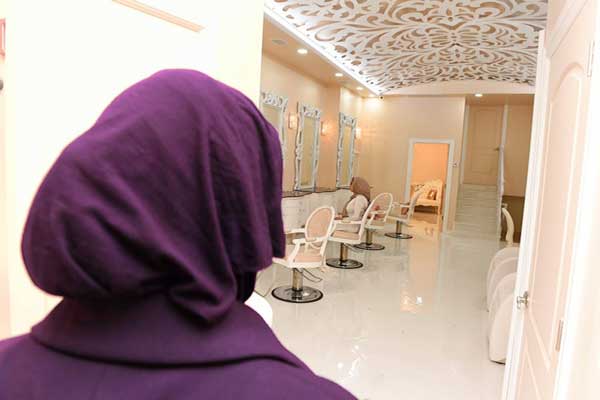February 1 is World Hijab Day. According to the website worldhijabday.com, “February 1st, 2013, marked the first annual World Hijab Day (WHD) in recognition of millions of Muslim women who choose to wear the hijab and live a life of modesty… [it is] a means to foster religious tolerance and understanding by inviting women (non-Hijabi Muslims/non-Muslims) to experience the hijab for one day.”
Actually, hijab is not mentioned in the Qur’an as a head-covering for women. The head-cover for women is mentioned in the Qur’an as a khimar. Hijab, on the other hand, is anything that screens or separates two things. For example, hijab is mentioned in 33:35 as a physical screen or curtain in the houses of Prophet Muhammad, separating his wives’ private spaces from the space of visitors. Hijab is also mentioned in 42:51 as a veil that separates humans from God. Hijab, as an invisible barrier, exists between those who recite the Qur’an and those who are wrongdoers, who do not believe in the Hereafter, and are averse to hearing about God in the Qur’an, according to 17:45-47. Based on this wider understanding of hijab, if a woman wears a headcover, she is wearing a khimar and one would hope that she has an inner hijab. That is, a barrier between her thoughts, words, and deeds and all that is base. The same applies to men. But how often it appears that Muslims relegate “hijab” to women, forgetting about its actual linguistic and Qur’anic meaning and its applicability to both genders. Almost like this: if all the women are wearing khimars and modest clothing, it proves that our society is practicing Islam and fulfilling its religious duty. But “the issue is much bigger than that,” as demonstrated in a narrative told by Sh. Muhammad Al-Ghazali.
Calling for Compassion and Patience
Shaykh Al-Ghazali was a scholar of classical Islamic learning and also had an extensive knowledge of modern science. He authored numerous books on Islam and was revered by so many Muslims. Graduating from Al-Azhar University in 1941, he was active in dawah and he recalls the day that a young woman came to see him. He took note that the way she dressed was not very modest. He says, “However, the look in her eyes revealed sadness and bewilderment that called for compassion and patience.” He spoke with her and found out that she was Arab but had been raised in France and had very little knowledge about Islam. The Shaykh told her about some fundamentals of Islam and answered all her questions. She requested a future appointment and then left. Sh. Al-Ghazali continues with the story. “Soon after, a young man – on whom qualities of outward Islamism were apparent – came storming into my office and said vehemently:
‘How come such a wicked person was admitted here?’
‘The job of a physician is to accept. He doesn’t typically see healthy people, does he?’ I replied.
‘Of course, you advised her to wear hijab!’ he added.
I said to him ‘The issue is much bigger than that. There is the foundation that has to be laid. There is the belief in Allah and the Hereafter. There is the hearing and the obeying of what was revealed in the Qur’an and the Sunnah, in addition to the pillars of worship and manners; the pillars that Islam cannot exist without …’ He interrupted me saying, ‘All of this does not mean we don’t order her to wear hijab.’
‘I wouldn’t like it if she came in a nun’s clothes while her heart is void of Allah. I taught her the basis that will help her to choose, on her own free will, to wear more decent clothes,’ I calmly replied. He tried to interrupt me again so I said firmly ‘I can’t drag Islam by its back end as you do. I lay the foundation and then start building and I usually achieve what I want with wisdom.’
Two weeks later, the girl came back. She was wearing much more decent clothes with a scarf over her head. She resumed her questions, and I resumed my teaching. Then I asked, ‘Why don’t you go to the nearest mosque to your home?’ I said that but immediately I felt remorse. I remembered that mosques are closed in the face of Muslim women. The girl answered that she hated the people of religion and that she did not like to listen to them. ‘Why?’ I asked. ‘They are hard-hearted, and they treat us with contempt and scorn,’ came her swift reply.
I don’t know why I remembered Hind [Abu-Sufyan’s wife]. She was the one who chewed Hamza’s liver and fought Islam vigorously until the 8th year of Hijrah. She did not really know the Prophet. However, when she knew him and saw his lenient manners, she told him ‘I never wished someone on the face of this earth to be humiliated more than you and your family. Now, I do not wish to see someone on the face of this earth more honored than you and your family.’ The Prophet’s kindness and sympathy changed the hearts of the people around him. Now, if only the people who give dawah today would learn from their Prophet. They would learn to draw together instead of driving away, and to bring good tidings rather than to say things that repel people away from them and from Islam.’”
Inner, Invisible Hijab
The different approaches of Sh. Al-Ghazali and the young man with “qualities of outward Islamism” are striking. Sh. Al-Ghazali was a moral man and, being a Muslim man who strived to emulate the Prophet (s), he would have been strong and disciplined in living a moral life. But as this story shows, that moral living also was infused with caring and compassion. The young man, on the other hand, appeared to be moralistic — hyper-focused on the morals of others and their real or perceived improprieties.
Even though Muslims use the misnomer “hijab” when what most mean is “khimar,” the general import is that women who cover their hair and bodies are doing so to be modest, to set a screen between their private femininity and non-mahram persons. So, the intention makes sense and is just fine. But here we are focusing on the meaning of “hijab” to be a screen or barrier that a Muslim establishes to keep himself or herself away from all that is base. Certainly, that is part of modesty. And it applies, of course, to women and men that this inner, invisible hijab should be wrapped around the heart and billowed freely in the mind so that the one with an inner hijab sees and interprets everything through a value system that both nurtures and guards, that is strong and merciful, that stands firm because it surrenders to truth.
If a man has this inner hijab, then he will do as Allah SWT enjoins of him (and of women, in verse 24:31) in the Qur’an: “Tell the believing men to lower their gaze and guard their modesty. That is purer for them. Verily, Allah is aware of what they do” (24:30). A beautiful balance of responsibility to protect individuals and society from debasement is established when both women and men enrobe their souls with an inner hijab, screening themselves from anything that pulls the individual away from surrender to Allah SWT. Because of this inner hijab, each one will be mostly focused, not on others’ infractions, but on what he or she can do to emulate the Prophet (s) and that includes showing kindness and compassion to people, to Muslims and non-Muslims, to family and friends and strangers. As Shaykh Al-Ghazali said, “They would learn to draw together instead of driving away, and to bring good tidings rather than to say things that repel people away from them and from Islam.” With inner hijab, a Muslim man knows that he is responsible for his actions regardless of how women dress, that he can’t blame others if he commits a wrong or a sin. Looking at a woman who has not yet surrendered to Allah SWT and seeing her as “wicked” and wanting most of all to “order her to wear hijab” will never change anyone’s heart.
Raiment of Righteousness
Without that inner hijab, a man might be tempted by his ego to be a scolder, a correctioner, a bully, a punisher, an authoritarian. Allah SWT says in the Qur’an, “We have not sent you [Muhammad] but as a mercy to the worlds” (21:107). And the most commonly invoked names of Allah are Ar-Rahman, meaning “The Most Compassionate” and Ar-Rahim, meaning “The Most Merciful.” The discipline and rigor, the willingness and ability and strength to protect and defend — these are manly traits that must be used to guard humanity, but also to nurture humanity. The discipline and rigor inwardly focused might make a scholar or at least a most knowledgeable and pious husband, father, or community leader who is known as one who looks around and says, often and astutely, “that called for compassion and patience.” He is never tempted by pettiness or moralistic reductionism for he sees that “the issue is much bigger than that” — much bigger than how a woman dresses. His willingness and ability and strength to protect and defend starts with fighting for balance in himself, an alignment with reality so that he sees beyond the outer cloak and knows that if a woman “came in a nun’s clothes while her heart is void of Allah,” nothing has been accomplished.
This genuinely virile man is committed to al-deen al-haneef, the way of those inclined, with their whole being, to a way of life steeped in devotion as they stand tall and firm with upright character. Yet, they have balance and moderation as footholds. Then they are able to discern things for what they are, to judge properly as to what is true and right. And so, this manly man might be like Sh. Al-Ghazali who stated, “I usually achieve what I want with wisdom.” He would know that “the Prophet’s kindness and sympathy changed the hearts of the people around him.” This man regularly secures the hijab wrapped softly around his own heart; and he cools his passions with the billowing hijab in his mind. For he has learned to be of those who do not “say things that repel people away from them and from Islam” but to “draw together…to bring good tidings…” His robe is taqwa — God-consciousness and fear of God. His protecting shield is taqwa, allowing him to love Allah’s mercifulness while blazing his own path with righteousness. And he knows he, himself, is imperfect and so he has a healthy sense of shame and that prevents him from being moralistic and harsh. Taqwa is like an inner and outer hijab, a barrier against all that would debase the soul.
“O children of Adam! Indeed, We have bestowed upon you raiment which covers your shame and provides protection and adornment. But the finest of all is the garment of taqwa. That is one of the signs of Allah so that they may take heed” (Qur’an 7:26).




